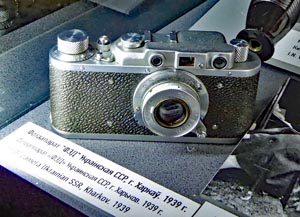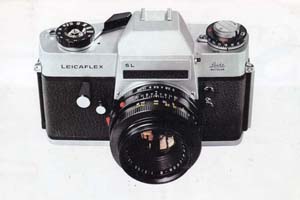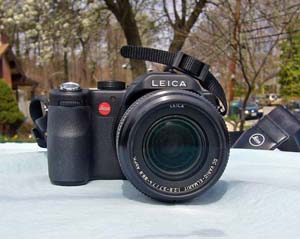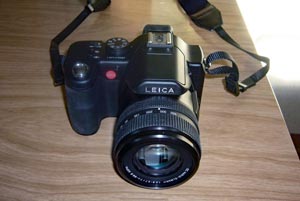Leica Cameras
- Canon P. In 1959, Korea was still a
very poor country. My parents were
eager to visit their son studying in the United States, but only one of them
could come. My father came with a gift from my mother. The gift was a
Japanese camera modeled after Germany's Leica. It was called Canon P with
lenses interchangeable with Leica lenses.
My mother was greedy, and she thought the camera quality was judged by
its lens size. The lens size of my Canon was 1.2/50, and its diameter
was as large as the height of the camera (the lens shown in this brochure
is 1.8/50mm). I was a graduate student at that time, and my camera was
admired by my classmates.
It had a detachable light meter without battery. It was powered by the photo-electric current generated by incident light. This kind of light meter had been around for sometime, but it was a new idea to couple it the camera.
I took many photos even after I moved to College Park near Washington, DC. In 1965, I took two successive photos of my infant son using this camera with this result. This partial superposition was due to the broken film advance mechanism. Even in the 1960s, Japanese products were not completely reliable. Canon was not Leica.
Yet, people still talk about this camera, and its role in shaping Japan as the dominant country in the world camera market. Click here for an interesting story. Here is another story. In 1961 and 1962, while in Princeton, I took the following important photos using my Canon camera.
- Dwight Eisenhower was the president of the United States from 1953 to 1961. Right after his retirement from the Whitehouse, he visited Princeton University to participate in the dedication ceremony of the John Foster Dulles room in the Princeton library. He was still guarded by secret service agents, but I was able to get close enough to take this photo. He said Hello to me. John Foster Dulles was Eisenhower's secretary of state.
- Adlai Stevenson came to Princeton in 1962 to participate in his 50th class re-union. Stevenson ran against Eisenhower in 1952 and again in 1956. He later served as the ambassador to the United Nations during the Kennedy administration. In this photo, Stevenson is leading his class of 1912 in the parade of Princeton alumni, called P-rade.
- Graduate College of Princeton University.
- A new PhD. I
got my PhD degree in 1961. I looked like this.

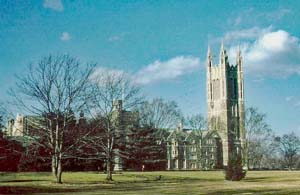
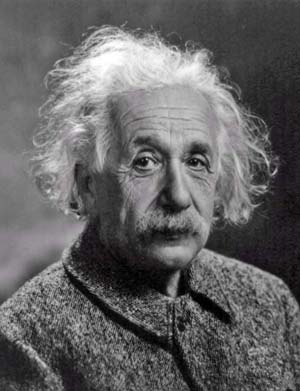
- Personal cameras were not common at that time, and people had to rely
on professional photographers for important events. Here is my photo
- with my father taken the day before my commencement in 1961. The photographer was Orren Jack Turner, who lived in Princeton until he died in 2008. He served in the U.S. Army during World War II, and inherited his father's photo studio after the war was over in 1945. He took
- Einstein's Photo in 1947. This photo is now owned by the U.S. Library of Congress, but is in the public domain.
- My photo with Einstein?
Moses wrote five books (in the Old Testament) in order to talk to
God. What did I do to have a photo with Einstein?
- In 1965, I and my wife were expecting a baby. We wanted to take
motion pictures of how our baby was growing up, and bought
these Bolex machines.
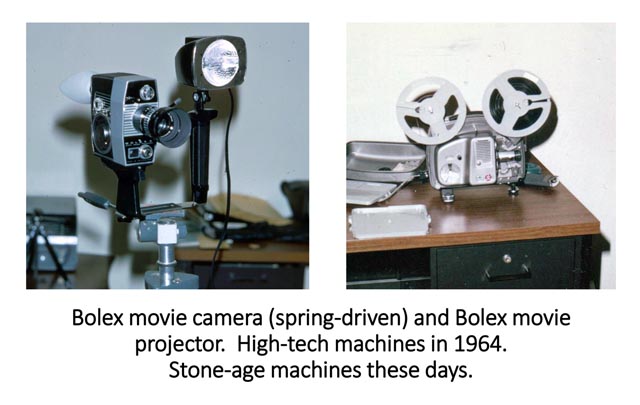

-
Bulky light meter on the first Nikon F

- During the the 60s, there appeared another Japanese camera in the
American market. It was called Nikon's single-lens reflex. Its photomic
version had a light meter coupled to the camera's speed-control system, but
it required a small battery (very strange at that time).
I bought one of them in 1965. I enjoyed this new machine and took many photos.
Let us look at some photos I took with the first model of Nikon F.
- Columns at the State University of New York in Albany.
- Harvard Science Center. Have you been there? If Yes, you should know where this photo was taken.
- Lyman Physics Laboratory of Harvard University. A traditional building.
- MIT Dome seen from the south side of the Charles River.
- Colonial Government in Williamsburg, Virginia.
Indeed, Nikon F was an advanced machine compared with my old Canon P. However, the camera with its light meter was too bulky, and Nikon introduced new models by correcting this and other shortcomings. In 1970, I sold my Nikon to someone and decided to buy a reflex version of Leica with Summicron 1.8/50 lens.

|
He was in Pyongyang when Soviet troops came to Korea's northern half after World War II. He claimed further that he stole his Soviet-made Leica from a Soviet army officer before coming to the South (it is more likely that his father bought this camera for him from the Soviet officer). Many Koreans moved from the North to South during the period (1945-48) because they disliked Kim Il-Sing's communist government being set up there.
Because of him, my curiosity in Leica became intensified. Since then, I had a dream of owning one of those Soviet-made Leica cameras.
Koreans are not the only ones crazy about Leica. Japanese and Russians attempted to produce their own Leica clones. Let us look at some of their products.
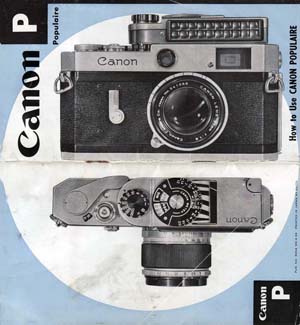
|
My Canon P with a giant 1.2 lens. |
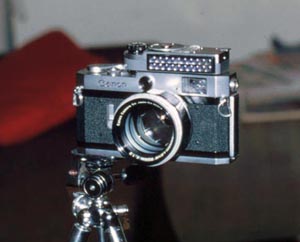
|
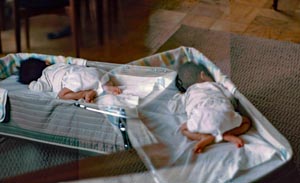
|
|
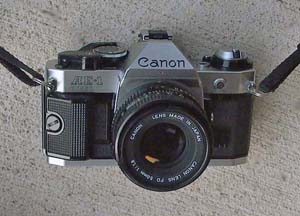
|
- Canon AE1 Program.
After losing my LeicaFlex, I was looking for a more practical alternative.
In 1975, Canon started marketing computer-controlled cameras. Its first
model was AE-1. Its chip controls the aperture for a given shutter speed.
I bought one of them and used it for two or three years. Canon later
came up with "Canon AE-1 Program" whose chip controls both speed and
aperture. Indeed, Canon produced more than three-million copies of
the Canon-AE1 series and established itself as the camera company for
both experts and non-experts.
With my "AE-1 Program," I took many photos including some of historical significance.
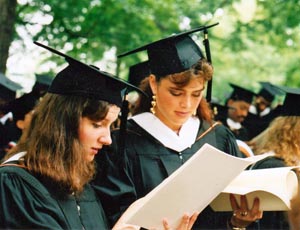

- Actress Brooke Shields in her graduation gown at Princeton University (1987).
- Green House Restaurant (1987) attached to the Nassau Inn in Princeton. Many famous visitors to Princeton used to have their breakfasts here, but this place became a Lindt chocolate store.
- Murray Gell-Mann talking to Eugene Wigner and John Bardeen at the University of Maryland (1988). All three of them are Nobel Laureates.
- Eugene Wigner with Mrs. Wigner at their home in Princeton (1991).
- Black/white Photo of the Rossborough Inn on the campus of the University of Maryland. George Washington used to stay at this Inn while making trips between Washington and Philadelphia. In 1981, black/white photos were acceptable, and some of them were quite respectable. This photo still has its distinction. Here is another black/white photo.
I do not use this camera these digital days, but it is still my favorite reflex camera. I always keep it in proper working condition.
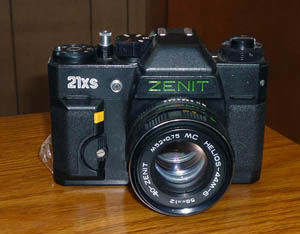
- Zenit Russian Camera.
In 1996, while I was attending a conference in Minsk (Belarus), I asked
my Russian friends what they produce in their city. They said they
produce excellent cameras. They then added their engineering tradition
came from Germany's Contax camera. I went to one of their camera stores
and asked their best camera. The store lady could not speak English
well, but she understood what I had in mind. She showed me two models
of the Zenit camera, one costing about $40 and the other about $60.
I took the $60 camera.
This is a reflex camera like the LeicaFlex I once had, and its mechanism was somewhat strange to me. It has a lens called Helios 6, with 2.0/55. Indeed, it is an excellent lens. The body is heavy and somewhat inconvenient to me, but it is very strong. This camera is still in excellent condition. I took some interesting photos with this camera.
- Deer crossing the Street, Greenbelt (Maryland).
- NASA Lake on the campus of the Goddard Space Flight Center in Greenbelt (Maryland).
- Swimming Ducks and ripples.
- Two Comedians at a Renaissance festival near Annapolis (Maryland).
- Artillery Re-enactment of Washington's Independence War. Once every year, there is a three-day meeting of battle re-enactments at the Mt. Vernon ground. There are 70 regiments of re-enactment army throughout the United States, and they assemble here to show their talents and dedication to General George Washington.
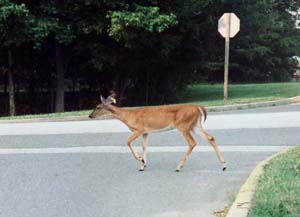
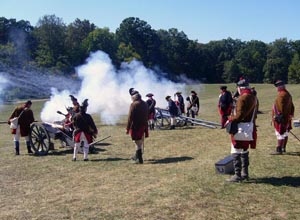
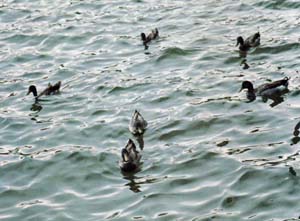
Yes, this camera could serve as a substitute for my lost LeicaFlex, but did not look like the Soviet Leica my high school friend was showing off in 1950. I then asked my Russian friends whether Zenit was making cameras before 1945. They said No, and said Russians were making Leica-clones at a factory named FED, and FED comes from the initials of a prominent communist named "Felix Edmundovich Dzerjinski" who was the first organizer of Russian secret police which later became known as KGB. This person did not know anything about cameras, but the camera factory was built within the ground of the youth rehabilitation center built and operated by this distinguished communist.
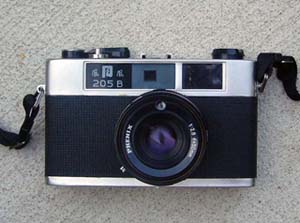
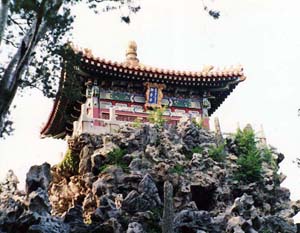
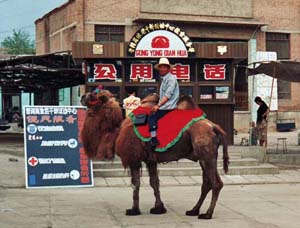
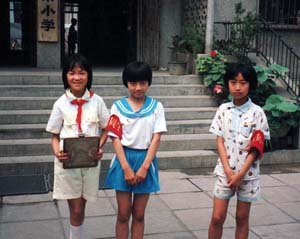
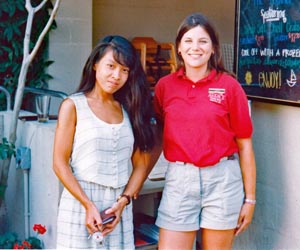
- Chinese FED/Leica. I bought this camera
when I visited China's Shanxi Province (west of Beijing and closer to the
ancient capital city of Xian) in 1995. The camera body was rather shabby,
but it produces great pictures. Here are some photos I took while in
China.
- Mount-top Temple, and
wall engravings. I was told
that this temple is more than 1200 years old. This means it was
built during the later half of China's Tang Dynasty.
- Town Center in country side. The big
Chinese characters say "Public Telephone." Apparently not every house
in this area has a telephone. It is a very peaceful town, and the
occasional appearance of this camel makes people happy. The camel rider
was telling me something in Chinese, but I could not understand.
Yet, I can tell you something. This area was a stopping point on ancient silk road. The commercial route existed thanks to camels.
- Chinese Children at their elementary school in Beijing. Two of them are wearing red bands, and they seem to have a special assignment.
- Beijing 1995. Bicyles, trolley
buses, and clean air.
- Japanese and American Girls at a restaurant in Annapolis (1996). This Japanese girl was a student at the University of Maryland. She used to come to my office whenever she became homesick, and I was like daddy to her. I used to take her to local cafeterias for brief meals. We once went to Annapolis and met an American student working at a restaurant. Annapolis is my favorite get-away place, and I maintain my Annapolis page.
Look at the camera's trademark. The camera's body has two identical Chinese characters separated by a figure of phoenix. In fact, the Chinese character means "phoenix." However, its lens has its trademark "phenix" in English. I do not know whether this misspelling was intentional or due to carelessness. In either case, this camera could be an excellent item for camera collectors.
I did not know at that time. But, after I bought the FED-5b camera in 1998, I developed a suspicion that this camera could be a Chinese clone of the Russian FED camera, which was a Soviet clone of Germany's Leica. Its appearance is very similar to that of FED-5b.
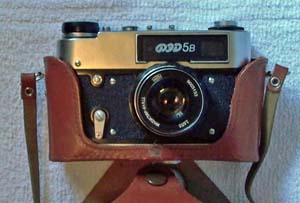
- Mount-top Temple, and
wall engravings. I was told
that this temple is more than 1200 years old. This means it was
built during the later half of China's Tang Dynasty.
- FED-5b Soviet Camera
I then concluded that the cameras Soviet soldiers brought with them to
North Korea must have been of the FED type. I thus bought a FED camera
while I was visiting Budapest (Hungary) in January of 1998. I paid $40 for its
model FED-5b, equipped with Industar-61 lens 2.8/53.
The internal mechanism of this camera was like that of old Leica cameras. For curiosity, I took many photos using this camera, with the following results.
- Color Resolution. This image will show how accurately and beautifully its lens produces colors.
- Sharpness. This is a photo of myself with my wife. You can see how sharp the people and environment are.
- Koreans from the North. Those Koreans who were in Northern part of Korea in 1945 had a chance to greet Soviet soldiers. They know that Soviet soldiers had magic cameras. I went to one of their meetings with this FED camera in order to impress them. I of course took pictures.
- Time Resolution. For indoor photos
at the meeting, I used a Canon flash light, which was not properly
synchronized with my FED. As a result, I ended up with a partial flash
exposure for each frame. The flash stops exactly at the same place for all the
pictures, as you can see from the two photos shown here.
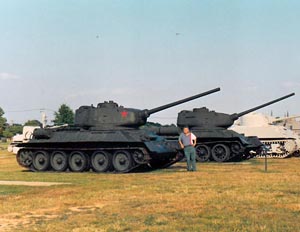
- T-34 Tank at a tank museum
in Aberdeen (Maryland 1998). In addition to the FED camera, the Soviet
Union had another outstanding industrial product. It was the T-34 tank.
In 1943, those T-34 tanks destroyed Hitler's 6th Army in Stalingrad, and
turned the tide of the Great Patriotic War (Russian name for WWII).
In 1950, the North Korean army used those T-34 tanks to invade the South.
Those tanks wiped out the (south) Korean army in three days. Two weeks
later, they destroyed the 24th Division of the U.S. Army.
Did you know both the FED camera and the T-34 tank were developed in the same Soviet city of Kharkov (now in Ukraine)? Here is a photo of myself in Kharkov in front of the tank at the city's central park. I was there in 1999 to attend a conference. I look OK with a tank, a lady, and soldiers. I used a Yashica pocket camera (not FED 5b) to produce this photo.
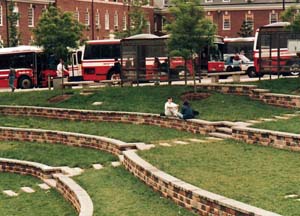
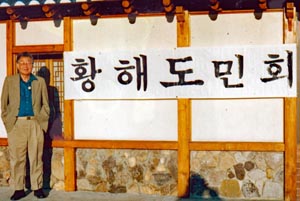
Indeed, you do not need a Leica if you have a Soviet FED. The only problem with my FED-5b is that it does not look like a Leica or the FED camera my high-school friend was showing off as a Soviet Leica in 1950. His camera did not have a light meter attached to it.
- FED-3 Soviet Leica. Thus, I googled around
for earlier versions the FED camera. Indeed, many FED cameras are available
through ebay trade. I bought (August 1998) this FED-3 camera from a dealer
in Severodonetsk (Ukraine). The price was very reasonable.
First of all, it looks like the Soviet Leica I saw in 1950. This camera was produced from 1961 to 1979 at the FED factory in Ukraine, and more than two million copies were made. This is why they are still available in the market.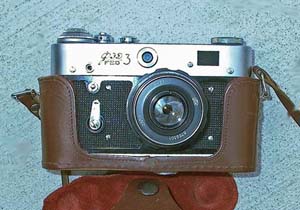
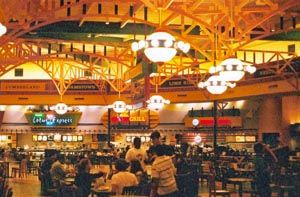

This camera is not exactly the same as the Soviet Leica my friend was showing off 1950, but looks like it. Close enough! The question is whether it produces good pictures. I took some photos with this camera and obtained the following result.
- Indoor Photo without Flash. I took several shots inside a shopping mall. This is the best of them.
- Campus Scene. Outdoor photos are also great.
- Close-up Photo. I took this photo of Queen Nofretete in a show window. Great!
- Trees and Leaves. See also bricks for the camera's resolving power.
- New Houses built in a suburban community.
I think I could take professional-quality photos if I become more familiar with this old machine. This camera costed me $70 including the air-freight cost from Ukraine. It is highly unlikely that I will use this FED for any practical purposes in this digital age. Yet, this antique machine will make this webpage much richer and elevate my image as a person who takes his own life very seriously.
Leica Cameras in Digital Age
-
The quality of a camera depends on two independent elements. One is
its lens system, and other is the accuracy of its shutter mechanism
and its durability. There have been revolutions in both fronts.
- Lumix LC40 (Leica Summicron Lens).
This is one of the earliest Lumix cameras with a Leica lens and a
Panasonic body. Because it was bulky and ugly, this model could not
compete in the U.S. market dominated by Canon and Nikon, although it did
well in Japan and Europe. The name "Leica" does not mean much to
cost-conscious Americans.
I bought this Lumix at a clearance sale (half price) because it has a Leica's Summicron lens. Leica markets its lenses with two popular tradenames, namely Elmarit and Summicron. Most of the Leica cameras carry Elmarit lenses, and "Summicron" sounds somewhat superior, but I do not have enough expertise to tell the difference. In addition, this camera has a very strong strobe.
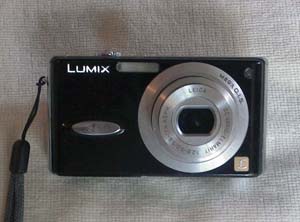
- Lumix FX6 (with Leica Elmarit Lens).
One major advantage of digital camera is that it is small. I bought this
pocket-sized Lumix camera for $220. This small machine does a great job
for my webpage photos. I do not need more than 2 mega pixels for web
photos, while most of the digital cameras those days offered more than 7
megs. This camera has the capacity of 5 megs. It is more than enough for
webpage purposes. I bought this camera in 2005, and its technology became
totally outdated.
The shutter mechanism is no longer mechanical. It is controlled electronically. Furthermore, it is coupled to the light meter system. The technology on this front is constantly developing. Thus, one has to buy a new camera every year. Leica body's untimate virtue of durability has no meaning to informed camera people.
How about Leica's lens system. Each Leica lens was hand-made by skilled craftsmen. This procedure is no longer acceptable. It is still essential for a human being to design lenses, but they now have to be mass-poduced by computer-controlled robots.
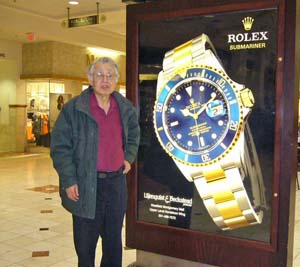
|
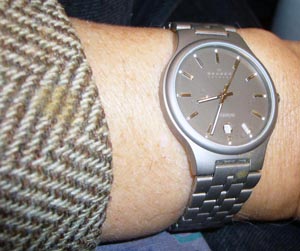
|
Skagen Titanium. However, in order to distinguish myself from ordinary people, I have to wear a special watch. I am wearing all-titanium watches these days. Titanium is a light metal used for space-crafts. Pilots wear titanium watches.
In order to survive in the consumer market, Leica had to switch to electronics. Instead of starting from zero, Leica decided to cooperate with an established electronics company in Japan, called Matsushita. This company markets its electronic products with a tradename "Panasonic."
Leica and Panasonic decided to produce a brand named "Lumix" with lens carrying the Leica mark, with a new technology called "image stabilizer." I do not know how it works. I like to know.
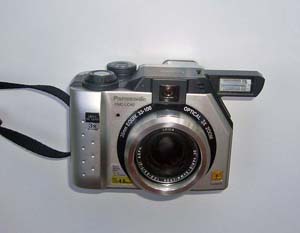
|
|
- Lumix FS15 (again with a Leica
lens).
This is a model of 2009. The price was $159 (deep discount).
It has new features, including optical image stabilization and face
recognition. In addition, it has automatic mode adjustment. This is
an essential feature for me. When I travel and pull out the camera
from my pocket, I do not have time to choose the mode to capture
interesting scenes.
Lumix cameras are not very popular with young Americans who cannot recognize "Leica," and the U.S. camera market is dominated by Nikon and Canon. For instance, I could not buy a spare battery for my Lumix FS3 in any of the camera stores in USA. I was lucky enough to find one in London while I was there in February of 2009.
The story is different in Europe. When I was in a Debenhams department store in London, two top-selling cameras were Lumix FS3 which I had, and Sony WS120 which I also had. Lumix and Sony carry Leica and Carl Zeiss lenses respectively. I was very proud of myself there.

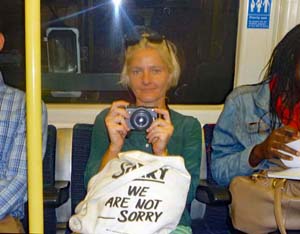
- British Professor from Birmingham.
I was sitting next to this professor at a conference banquet table in
Shanghai (July 2011). She travelled around the world, and was self-assured.
She was carrying her Lumix camera. I gave my Lumix camera to her husband to
take this photo, telling him I want to have a photo with a British professor.
She then gave her Lumix to her husband telling him she wants to have a photo
with an American professor.
Lumix Fan in London. This young lady was sitting in front of me in a London subway train. She was carrying her Lumix camera, so was I. We praised each other for choosing the right camera, and took photos of each other. In Europe, the Lumix is the most popular camera brand, while Canon and Nikon dominate the camera market in the United States. In London, I check its brand whenever I meet a person with a camera. I still have to find someone in London with a camera other than Lumix.
Although I was able show off myself as a sophisticated camera owner to those ladies, their Lumix cameras were bigger than mine. While I was carrying my camara in my pocket, they were carrying theirs in their handbags.
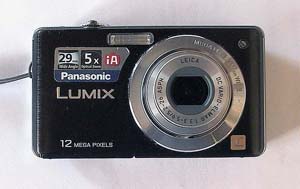
|
- I should therefore have two cameras called Leica M1 and Leica Carbine.
I can still carry my Leica Carbine in my pocket, but should carry my Leica
M1 in a separate camera case. With this determination, I decided to buy a
larger camera (of the size owned by those British ladies).
- As my Leica M1, I bought in 2010
Lumix ZS8 with a zoom power of 16x.
- As my Leica Carbine, I kept my pocket-sized Lumix FS15 with zoom power of 7.8x.
In this way, I was able to construct my first system of Leica M1 and Leica Carbine. Both Lumix cameras have Elmarit Leica lenses.
Let us see what my Leica M1 (Lumix ZS8) can do. While I was in Nanjing (China 2013), I spotted from a moving car (at the speed of 100 kph) a Chinese tower at the top of a mountain.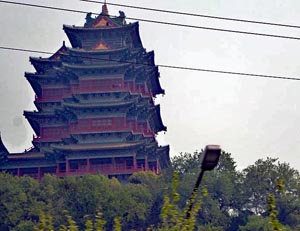
-
A Chinese tower about 1 kilometer from my Leica M1.
Roof tiles can be seen.
I took this photo from a car moving at speed of 100 kph.
My camera could not clear up smogs in Chinese cities.
- I spotted this tower from a large distance.
- I then increased the zoom power. This photo shows the details of the windows.
- This photo shows the roof tiles of the tower.
The Lumix ZS8 is a very powerful Leica camera. Although I own many cameras, I do not regard myself as a professional photographer. I just take many pictures and choose only good ones. Yes. I heard that this is what the professionals take their photos. With digital cameras, I can take thousands of photos without worrying about the cost of films. However, it is safe to say that I am not a professional. I still have to learn where the gap is.
As for the cameras, each of them needs a separate battery charger. It is very inconvenient to carry two battery chargers, especially when I make trips to foreign countries. I sometimes leave the charger in the hotel room. The camera company knew this problem and came up with USB charging system.
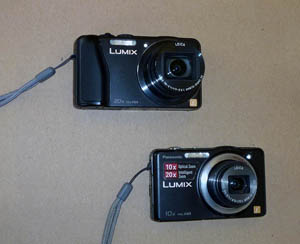
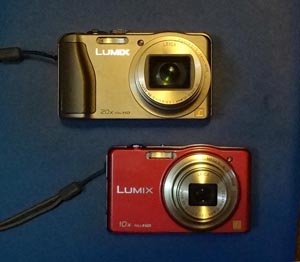
- As my Leica M1, I bought in 2010
Lumix ZS8 with a zoom power of 16x.
- Thus, I had to construct a new set of
Leica M1 and Leica Carbine.
- My new Leica M1 is Lumix ZS25
with zoom power of 20x.
- My new Leica Carbine is Lumix SZ7 with its zoom power of 10x.
These models have Leica lenses larger than those for my earlier cameras. Their batteries can be charged through USB cables. Thus, one cable can take care of both cameras, and it is easy to carry one or two extra USB cables.
I like this set of two cameras so much that I have the second set of the same cameras with different colors.
- My new Leica M1 is Lumix ZS25
with zoom power of 20x.
- Alas, the concept of M1 Garand and M1 Carbine is thoroughly outdated.
The U.S. Army started using M16 rifles from 1962. Thus, I should
now carry Leica M16. Indeed, Leica and Lumix could read my mind
exactly. The Leica thus came up with its Leica C. This model is
available from the
Amazon.com for $700.
However, the price is out of reach even for a Leica-crazy man like myself. Fortunately, there is an axially the same camera with a different skin. It is Lumix LF1, which I bought for $250.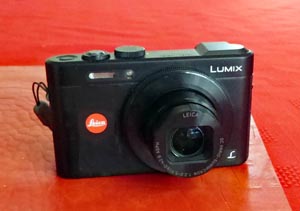
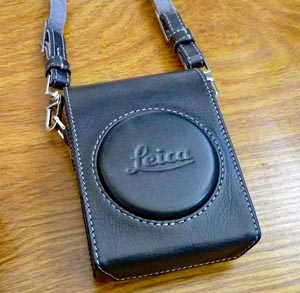
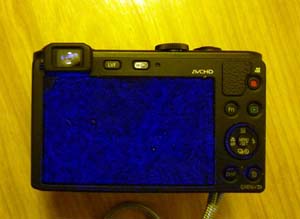
- This camera is lighter than Leica M1 and heavier than Leica
Carbine. I can carry this model either in my pocket or
its own Leica case, drawing admirations from camera fans.
- This camera has its trade name "Lumix" at the upper-right
corner of the front surface, but has a large empty area left of
the lens. This allows me to put a red-orange Leica trademark.
Thus, it is a perfect Leica to who can recognize the Leica
trademark.
- It has a Leica Summicron lens with the zoom power of 20x,
while most of the Leica or Lumix cameras have Elmar and Elmarit
lenses. I do not know technical details, but it is said that
the Summicron lenses are superior.
- In addition to its monitor, this camera has a digital view
finder. Monitors are totally ineffective in bright daylight.
This eyepiece is a very useful tool to see the picture you are
taking.
- This camera, with a faked Leica logo, is OK. I can still impress everybody in the world. However, it does not have enough zooming power to satisfy my needs. Why? Continue reading.
- This camera is lighter than Leica M1 and heavier than Leica
Carbine. I can carry this model either in my pocket or
its own Leica case, drawing admirations from camera fans.
- Leica's Summicron lenses have excellent resolving powers. They can produce
fine details of your skin, but they are not designed for flexible local length.
On the other hand, Leica's Elmar or Elmarit lenses allow variation of local
length. Thus, they are more suitable for zoom lenses.
With this point in mind, Panasonic replaced the Summicron lens of the above-mentioned LF1 camera with an Elmar lens, with a zoom power extending to 30x. This camera is called Lumix ZS50, and it seems to be very popular among the Lumix fans.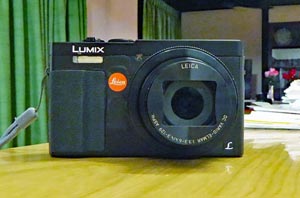
While the above-mentioned Lumix LF1 is equivalent to Leica's Model C with its zooming power of 7x, there does not seem yet to be a Leica equivalent to this popular Lumix camera, but its lense is still a Leica. Thus, I attached a Leica trade mark to this new camera.
-
Indeed, this makes another perfect combination of the Carbine (for short range) and the M1 (for long lange) both carrying the Leica mark. It is not right to add Leica marks to these Lumix cameras, but I am still OK as long as I do not sell them for profit.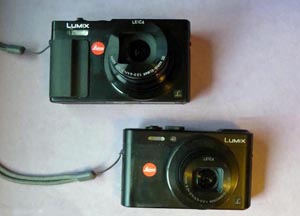
- The Lumix cameras are manufactured by Panasonic Electronics Company,
established in 1916 as Matsushida Electric Company in Japan. Panasonic
is now one of the largest electronics firms in the world. Panasonic
is marketing their personal cameras with the following three trade names.
- Lumix cameras with Lumix lenses, for moderate prices. I have
one camera with a Lumix lens. It
also produces great pictures.
- Lumix cameras with Leica lenses, for reasonable prices.
- Leica cameras with Leica lenses, for high prices.
For every Leica camera produced by Panasonic, there is the same Lumix camera. The only difference is its skin. However, the price difference is substantial.

Not all Lumix cameras have their Leica counterparts. Since however, all Leica camera bodies are made by Panasonic, It is safe to say all Lumix cameras with Leica lenses are Leica cameras.
This allows me to own as many as nine Leica cameras. Why so many? Unlike mechanical film cameras of the 20th Century, electronic camera bodies become constantly out-dated. Those out-dated cameras still produce excellent pictures, but I cannot live with out-dated technologies. I may have to buy another Leica soon.
- Lumix cameras with Lumix lenses, for moderate prices. I have
one camera with a Lumix lens. It
also produces great pictures.

|
Contax Cameras
- Click here for a story.
Digital cameras can change your world.
- This world becomes
quite different if you carry a digital camera in your pocket.
You do not have to worry about the cost of films. You can take photos
continuously while you travel. From those photos, you can construct
webpages. Here, in your webpage, would you place those photos in
chronological order?
- Sergei Eisenstein
was a creative Soviet film maker during the Soviet era. His approach
was to take pictures first, and then construct a story by arranging
the photos. This is precisely what you are doing in making webpages.
- Garden of Eden. Have you
been there? Let us create its webpage.
- Beautiful Hearts and Minds.
Do you know how to photograph these abstract concepts?
- During the 19th Century, French artists painted pictures of affluent life style of Parisians. These days, the United States is a very affluent country. Let us see whether we can represent this abstract concept of affluence with a set of photos collected over the years. Click here to see what I am talking about.
- Sergei Eisenstein
was a creative Soviet film maker during the Soviet era. His approach
was to take pictures first, and then construct a story by arranging
the photos. This is precisely what you are doing in making webpages.
- My interest in cameras comes not only from photography but also my stronger
interest in machines. Unfortunately, I cannot collect all of them. Here
are the items I like but cannot have in my house.
- Webpages. During my high-school years,
I picked up a keen interest in electronics, and then
short-wave radios. While listening to
the world, I developed a strong passion for talking to the world. I felt
like building a strong radio transmitter and talking to the microphone
all day. This was of course an impossible dream.
- Thanks to the advancement of communication technologie, I am now able to construct
webpages and attract people to come to my pages. Pictures and figures
play the central role in this new mode of communication. I need
digital cameras, and I have to keep up electronic technologies built into those
cameras.
- Click here for a brief history of wireless communication.

-
This electronic box of 1952 led to my passion to talk to the people
far away from me.
- Webpages. During my high-school years,
I picked up a keen interest in electronics, and then
short-wave radios. While listening to
the world, I developed a strong passion for talking to the world. I felt
like building a strong radio transmitter and talking to the microphone
all day. This was of course an impossible dream.

|
|

|
- copyright@2016 by Y. S. Kim, unless otherwise specified.
- Who is responsible for this webpage?
-
Click here for his home page.
- His style page.
- His Einstein page.
-
Click here for his home page.
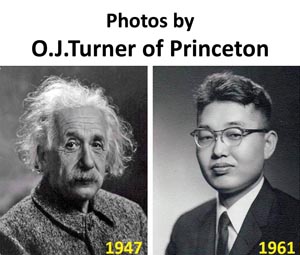
| |
|
